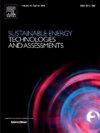Inspired by L-shaped hammer stockbridge damper: A multi-band dual-beam coupled vibration piezoelectric energy harvester
IF 7.1
2区 工程技术
Q1 ENERGY & FUELS
Sustainable Energy Technologies and Assessments
Pub Date : 2025-06-30
DOI:10.1016/j.seta.2025.104422
引用次数: 0
Abstract
Inspired by L-shaped hammer Stockbridge damper on overhead transmission lines, this work proposes a novel multi-band dual-beam coupled vibration piezoelectric energy harvester for efficiently harvesting cable vibration energy. The harvester’s core comprises two dual-beam piezoelectric oscillators, which together can generate a total of four harvesting frequency bands through structural parameter adjustments, extending the operational range. To evaluate performance, finite element analysis and experiments were used to investigate the influence of key parameters. The work revealed that the beam spacing (D), length ratio (Lr), and additional mass (M2) significantly affected the second-order vibration mode. Specifically, D = 38 mm, Lr = 0.54, and M2 = 3 g represented the critical points for the transition of the second-order vibration mode. The coupled structure enables the specific Lr and M2 to effectively enhance the output of the floating cantilever beam at its first-order resonance. Furthermore, the work investigated the harvester’s capability to harvest vibration energy from different directions. Under baseline conditions, the power densities at first-order resonance for the elastic supporting beam and floating cantilever beam are 16.967 mW/cm3 and 1.767 mW/cm3, respectively, and 4.45 mW/cm3 and 11.20 mW/cm3 at second-order resonance, providing stable power to wireless sensor nodes in the environment.

受l型锤型stockbridge阻尼器的启发:一种多波段双梁耦合振动压电能量采集器
受架空输电线路上l型锤式斯托克布里奇阻尼器的启发,本文提出了一种新型的多波段双梁耦合振动压电能量采集器,用于高效地收集电缆振动能量。收割机的核心由两个双梁压电振荡器组成,通过结构参数的调整,可以产生共四个收获频带,扩大了工作范围。为了评估其性能,采用有限元分析和实验方法研究了关键参数的影响。研究表明,梁间距(D)、长度比(Lr)和附加质量(M2)对二阶振动模式有显著影响。其中,D = 38 mm, Lr = 0.54, M2 = 3g是二阶振动模式转变的临界点。耦合结构使特定的Lr和M2能够有效地增强悬浮悬臂梁在一阶共振时的输出。此外,研究了收割机从不同方向收集振动能量的能力。基线条件下,弹性支承梁和浮动悬臂梁的一阶共振功率密度分别为16.967 mW/cm3和1.767 mW/cm3,二阶共振功率密度分别为4.45 mW/cm3和11.20 mW/cm3,为环境中的无线传感器节点提供稳定的功率。
本文章由计算机程序翻译,如有差异,请以英文原文为准。
求助全文
约1分钟内获得全文
求助全文
来源期刊

Sustainable Energy Technologies and Assessments
Energy-Renewable Energy, Sustainability and the Environment
CiteScore
12.70
自引率
12.50%
发文量
1091
期刊介绍:
Encouraging a transition to a sustainable energy future is imperative for our world. Technologies that enable this shift in various sectors like transportation, heating, and power systems are of utmost importance. Sustainable Energy Technologies and Assessments welcomes papers focusing on a range of aspects and levels of technological advancements in energy generation and utilization. The aim is to reduce the negative environmental impact associated with energy production and consumption, spanning from laboratory experiments to real-world applications in the commercial sector.
 求助内容:
求助内容: 应助结果提醒方式:
应助结果提醒方式:


